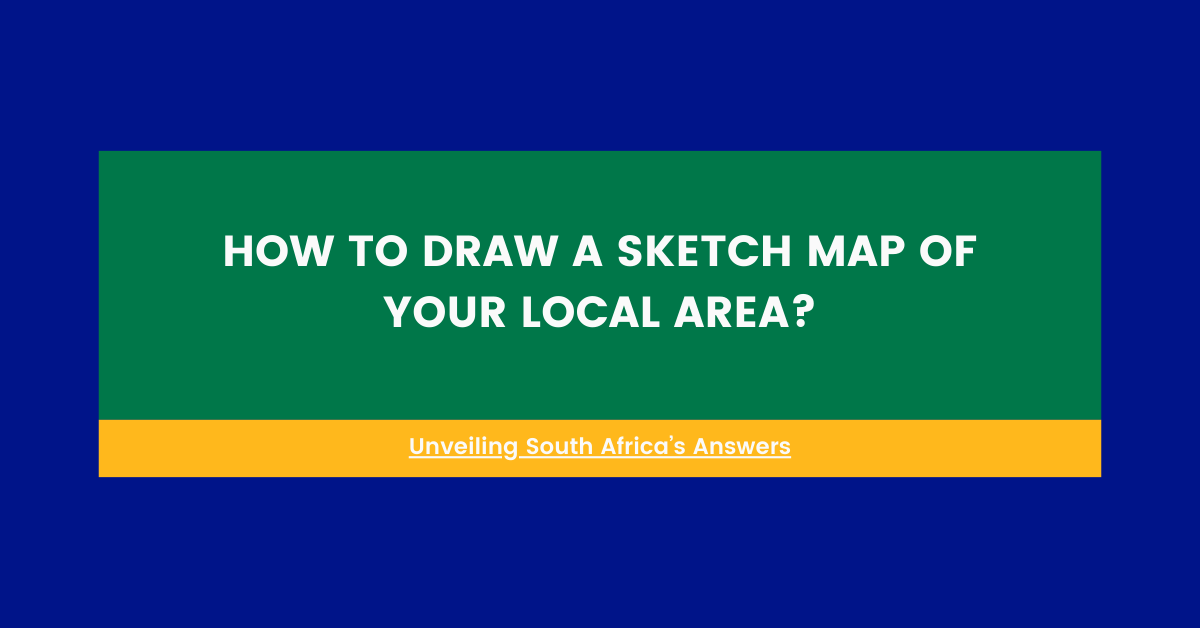Drawing a sketch map of your local area is a fun and useful skill, especially in South Africa where diverse landscapes and urban layouts create unique geographical challenges. Whether you’re a student working on a school project, a tourist trying to navigate a new town, or simply someone who wants to better understand their surroundings, this guide will help you create an informative and accurate sketch map.
What Is A Sketch Map?
Before we dive into the process, let’s define what a sketch map is:
- A simple, hand-drawn representation of an area
- Shows key features and landmarks
- Not necessarily to scale, but proportionally accurate
- Uses symbols and labels for clarity
Why Draw A Sketch Map?
Sketch maps are valuable for several reasons:
- They help you understand your environment better
- Useful for giving directions to others
- Can highlight important features of an area
- Develop spatial awareness and geography skills
Materials You’ll Need
To draw your sketch map, gather these items:
- Paper (plain or graph paper works well)
- Pencil and eraser
- Colored pencils or markers (optional)
- Ruler (optional, for straight lines)
Steps To Draw Your Sketch Map
Follow these steps to create your local area sketch map:
Step 1: Determine Your Area
First, decide what area you want to map:
- A neighborhood
- Town center
- School grounds
- Local park
For this example, let’s imagine we’re mapping a typical South African neighborhood.
Step 2: Identify Key Features
Before you start drawing, list the main features of your area:
- Major roads (e.g., Main Street, Church Street)
- Landmarks (e.g., Nelson Mandela Square, local spaza shop)
- Natural features (e.g., Jukskei River, Koppies)
- Important buildings (e.g., post office, police station)
Step 3: Decide On Map Orientation
Choose which direction will be at the top of your map:
- North is traditional, but not necessary
- Consider the shape of your area and what orientation makes sense
Step 4: Draw The Main Roads
Start with the major roads in your area:
- Use straight or gently curved lines
- Make main roads thicker than smaller streets
- Label the roads clearly
Step 5: Add Landmarks And Key Buildings
Now, place your identified landmarks on the map:
- Use simple shapes (squares for buildings, circles for roundabouts)
- Make important features slightly larger for emphasis
- Add labels in clear, printed letters
Step 6: Include Natural Features
Don’t forget to add natural elements:
- Rivers can be wavy blue lines
- Parks can be green shapes
- Hills or koppies can be shown with simple contour lines
Step 7: Add Smaller Streets And Features
Fill in the details:
- Residential streets
- Local shops
- Schools
- Sports fields
Step 8: Create A Key Or Legend
Explain any symbols you’ve used:
- Use a small box in a corner of your map
- Show what each symbol represents (e.g., a cross for a church)
Step 9: Add A Title And Date
Give your map a clear title:
- “Sketch Map of [Your Area Name]”
- Include the date you drew the map
Step 10: Optional: Add Color
Color can make your map more visually appealing and easier to read:
- Green for parks and nature areas
- Blue for water features
- Different colors for different types of roads
Tips For Accuracy
While sketch maps aren’t exact, you can improve accuracy:
- Walk or drive around your area to refresh your memory
- Use online maps as a reference, but don’t copy directly
- Ask locals to confirm locations if you’re unsure
Common Symbols Used In South African Maps
Incorporate these common symbols in your sketch map:
- Spaza Shop: Small square with “Spaza” label
- Taxi Rank: “T” in a circle
- Braai Area: Small grill icon
- Rugby/Soccer Field: Oval or rectangle with goalposts
- Shebeen: House icon with a bottle
- Township: Cluster of small squares
Adapting Your Map For Different Purposes
You can customize your sketch map for various uses:
- Tourist Map: Highlight attractions and accommodations
- School Route Map: Show safe walking paths and crossing points
- Emergency Map: Mark fire hydrants, hospitals, and police stations
Using Technology To Enhance Your Sketch Map
While traditional hand-drawing is valuable, you can use technology to support your map-making:
- Online Research: Use Google Maps or OpenStreetMap to verify locations
- Digital Drawing: Try apps like Procreate or Adobe Sketch for digital maps
- GPS Data: Use a smartphone to accurately plot key points
Teaching Sketch Mapping In South African Schools
Sketch mapping is an important skill taught in South African geography classes:
- Helps students understand their local environment
- Develops spatial awareness and orientation skills
- Encourages observation and attention to detail
Cultural Considerations In South African Sketch Maps
When drawing a sketch map in South Africa, consider these cultural aspects:
- Include both official and local names for places
- Represent diverse areas accurately (e.g., townships, suburbs)
- Be sensitive to historical contexts of certain locations
Challenges In Sketch Mapping South African Areas
Some unique challenges you might face:
- Informal Settlements: These can be difficult to map accurately
- Rapidly Changing Urban Areas: New developments may not be on official maps
- Rural Areas: Sparse landmarks can make orientation challenging
Using Your Sketch Map
Once you’ve created your sketch map, you can use it for:
- Giving Directions: Help visitors navigate your area
- Emergency Planning: Identify evacuation routes or safe meeting points
- Community Projects: Plan neighborhood improvements or events
- Personal Reference: Understand your surroundings better
Improving Your Sketch Mapping Skills
To get better at drawing sketch maps:
- Practice regularly with different areas
- Compare your maps with official maps to check accuracy
- Ask for feedback from locals familiar with the area
- Try mapping from memory, then check your work
